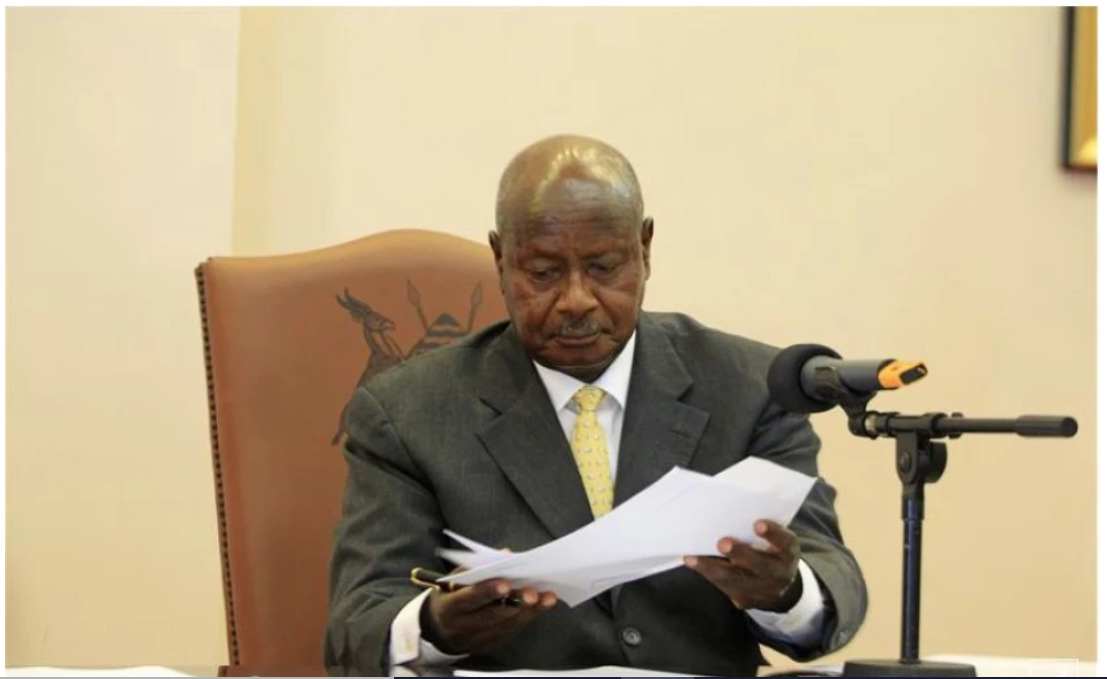Uganda President Yoweri Museveni has spoken out on Friday Al-Shabaab attack on African Union camp manned by Ugandan soldiers in Lower Shebelle Region.
At 5am, more than 800 fighters allied to the Al-Qaeda-linked terrorists stormed and overran the African Union Transition Mission in Somalia (ATMIS) at Buulo Mareer— killing scores of Ugandan troops before carting away weapons.
In a statement published on his Twitter handle, President Museveni faults his military’s preparedness and response to the attack, which he says was a “missed opportunity” to deal Shabaabs a blow.
He questions the qualifications and abilities of some the soldiers deployed to frontline, going to the extent of suggesting that a number enlisted merely to earn “UN allowances”.
The Commander-In-Chief also provides the first detailed information on the attack, revealing why the militants easily overran the facility manned by up to 200 soldiers.
He reveals that some of the soldiers panicked, and Al-Shabaab took advantage of their disorganisation to overrun the base and destroy some of the equipment.
Panic
“The panic, it seems, was totally unnecessary because both the anti-tank ditch and our soldiers had destroyed the three vehicles of explosives outside the FOB. The suicide bombers or whatever, were forced to blow themselves up before they gained entry into the base,” he says.
During the attack, Museveni says his troops withdrew to the next Forward Operating Base (FOB), some nine kilometres away, giving the heavily armed attackers access to the targeted base.
The attackers were about 800, according to data captured by Unmanned Aerial Vehicles (UAV), commonly known as drones.
Mr Museveni questions the response of the forces at the base and the failure of both human and technology intelligence to detect the attackers.
He says panic was a missed opportunity to conquer the terrorists as the suicide bombers had already blown themselves outside the base.
At the time of the attack, the president says, the Ugandan soldiers were armed with two tanks, two 14.5mm anti-air-craft guns and a 107mm Katyusha rocket launcher.
“Some of the soldiers there did not perform as expected and panicked, which disorganised them and Al-Shabaab took advantage of that to overrun the base and destroy some of the equipment.”
Outnumbered
“Moreover, our UAVs were watching the whole scenario from up in the sky and directing fire. The Chief of Defence Forces (CDF) has set up a Board of Inquiry (BOI) and the full facts will come out, including the details of the casualties,” the President added.
The statement also reveals that Al-Shabaab easily outnumbered the soldiers. The size of a military company ranges from a few dozens to 200 soldiers.
“The operations are continuing and they will regret their actions,” warned General Museveni, who dispatched his Land Forces commander Lt Gen Kayanja Muhanga to Somalia on Saturday.
“Condolences to the country and the families of those who died. This unfortunate incident should be used to remind all those concerned that operations in Somalia and other theatres are combat missions and not welfare missions where you can access UN allowances,” Mr Museveni said.

Vowing action against the militia, the president said UPDF has operated the base successfully since 2007 but despite having quite strong defences, it was being guarded by light weapons.
“It is criminal for anybody involved to send into such a theatre soldiers who are either not suited for that mission or nor properly prepared for it,” he added.
News of the attack was first spread by the terrorists, with statements by ATMIS and Uganda People’s Defence Forces Spokesperson failing to disclose the extent of the attack and casualties.
While Museveni did not reveal the number of casualties and soldiers taken hostage by the terrorists, he acknowledged that “many lives” were lost.
ATMIS noted that reinforcements from its aviation unit and allies managed to destroy weapons seized by the militants.
Condelences
UPDF Spokesperson Brigadier Kulaigye said a team led by Commander of Land Forces Kayanja Muhanga had been dispatched to Somalia to ascertain the circumstances under which the attack happened and chart the way forward.
The attack has since been condemned by the Somali government which in a statement said it appreciated the sacrifices made by troops fighting to free the Horn of Africa nation from the grip of terrorism.
“The Federal Government of Somalia conveys its deepest sympathies to the people and leadership of the Republic of Uganda, the African Union Transition in Somalia at large as well as the Somali National Armed Forces. We condole with the victims’ families and wish the injured a speedy recovery. To our heroes who paid the ultimate price, your sacrifices will never be forgotten,” read the statement in part.
ATMIS (formerly Amisom) has suffered a series of heavy losses at the hands of Al-Shabaab in its 18-year campaign to restore stability in the war-wracked Horn of Africa nation.
Such attacks, experts say, are designed to hasten the departure of the mission, which has been fighting al-Shabaab for more than a decade.
Several troop-contributing countries, including Kenya, Uganda and Burundi, have lost soldiers and equipment to the rag-tag militia that has been seeking to impose Sharia rule.
On April 1, dozens of Ugandan soldiers were killed when the Islamist extremists attacked their base at Bulamarer town, 80 miles south-west of the capital, Mogadishu.
Kenyan base
On May 4, 2022, at least 30 Burundian soldiers were killed and 20 others injured in an attack on El-Baraf AU base, about 150 kilometers north of Mogadishu.
On January 15, 2016, more than 141 Kenyan soldiers were killed and over a dozen taken hostage, in a battle that turned out to be the deadliest attack on peacekeepers in the history of modern peace operations.
On the fateful day, a a suicide bomber detonated a truck loaded with explosives at the base, the cue for hundreds of fighters clad in camouflage gear to attack.
The raid saw thousands upon thousands of bullets fired by some 300 Al-Shabaab militants in a brutal assault on Kenyan soldiers. The base was only reclaimed more than 72 hours later after several foiled attempts at reinforcement by the military in Kenya.
Preparing to leave
The U.N. Security Council, which authorised the new mission, gave it a mandate to reduce the threat posed by Al-Shabaab.
ATMIS is also required to support the capacity building of Somali security forces, and conduct a phased handover of security responsibilities to the Somali government. The mission’s mandate runs through the end of 2024.
And after 18 years, ATMIS now says that they are preparing to withdraw 2,000 troops from the Horn of Africa nation by June 30, 2023, the first of three drawdowns in its transition plan.
That plan would see ATMIS troop levels decrease from the current 18,586 to just more than 9,500 at the end of the transition period in late 2024.
Somalia intends to gradually ramp up its force levels to about 23,000 and take over when ATMIS liquidates its assets and fully withdraws.
Last week, Somalia said that after three multinational peace missions, they were getting ready to take full control of its own security.




